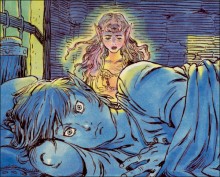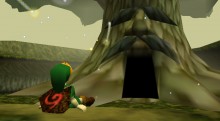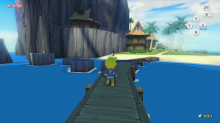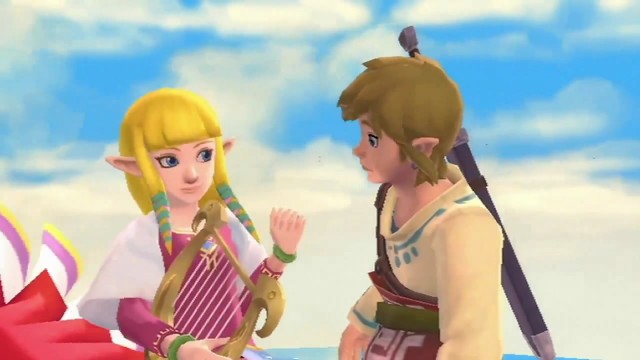A Look Back at Introductions in Zelda
Posted on August 23 2014 by Mark Olson
 As a longtime fan of the Zelda franchise, I have played through my fair share of Zelda introductions. Some have worked extraordinarily well, throwing you directly into the action while allowing you to learn the ropes. Others haven’t been as successful. I won’t look at each and every introduction to a Zelda game; instead, I will only look at opening acts that I feel are different enough (either in structure or quality) from others in the series to merit a mention.
As a longtime fan of the Zelda franchise, I have played through my fair share of Zelda introductions. Some have worked extraordinarily well, throwing you directly into the action while allowing you to learn the ropes. Others haven’t been as successful. I won’t look at each and every introduction to a Zelda game; instead, I will only look at opening acts that I feel are different enough (either in structure or quality) from others in the series to merit a mention.
Let’s start where the series started- the original Legend of Zelda. This introduction is wholly remarkable not because of its intro, but because of the lack thereof. The game sits you in the middle of the game world and allows you to go whichever way you want; the complete and total lack of restrictions is refreshing when gone back to. The very fact that there is a no-sword run going around on the internet speaks to the liberty and choice that this game allows you to have. When played in comparison to the 3-D titles, it feels like a perfect introduction.
 Our next game has my favorite introduction ever. I am speaking of A Link to the Past. This game launches when Link receives a telepathic message from Princess Zelda, telling the player of her whereabouts in the castle and her need for a hero to save her. Link’s uncle, who he lives with, heads out into the stormy night and warns Link about going outside. Link disobeys his uncle’s orders, grabs a lamp, and walks out into the storm. Upon nearing the castle, Link receives another message from Zelda, who divulges information about a secret passage into the castle. Link drops down a hole into what would appear to be a sewer system, only to find his uncle dying. Link is then endowed with the sword and shield that belonged to his now dead uncle. This all happens within five minutes. Right off of the bat, the player has a motive, a mission, and the tools to complete it. The game doesn’t treat you like the singular proof that man is descended from ape like later games in the series, and I appreciate that. A Link to the Past’s introduction, though rather lacking in freedom, is nothing if not exhilarating. It cuts to the chase, and the chase is awesome.
Our next game has my favorite introduction ever. I am speaking of A Link to the Past. This game launches when Link receives a telepathic message from Princess Zelda, telling the player of her whereabouts in the castle and her need for a hero to save her. Link’s uncle, who he lives with, heads out into the stormy night and warns Link about going outside. Link disobeys his uncle’s orders, grabs a lamp, and walks out into the storm. Upon nearing the castle, Link receives another message from Zelda, who divulges information about a secret passage into the castle. Link drops down a hole into what would appear to be a sewer system, only to find his uncle dying. Link is then endowed with the sword and shield that belonged to his now dead uncle. This all happens within five minutes. Right off of the bat, the player has a motive, a mission, and the tools to complete it. The game doesn’t treat you like the singular proof that man is descended from ape like later games in the series, and I appreciate that. A Link to the Past’s introduction, though rather lacking in freedom, is nothing if not exhilarating. It cuts to the chase, and the chase is awesome.
 There is one major change between A Link to the Past and our next game: the third dimension. Ocarina of Time was not only tasked with introducing players to a new Zelda game, but giving the players what was, for many, their first taste of an adventure game in 3-D. Ocarina of Time completed this tall task with nothing if not grace and finesse. The introduction is rather minimalistic when compared to what it needed to do. Navi tells the player to meet with the Great Deku Tree, but, upon attempting to do so, Mido (who may have been born from the bowels of hell) tasks Link with finding a sword and shield. These missions are simple in nature, but never boring. This section doesn’t last more than ten minutes, and the player is thrown into the first dungeon, The Great Deku Tree, directly after.
There is one major change between A Link to the Past and our next game: the third dimension. Ocarina of Time was not only tasked with introducing players to a new Zelda game, but giving the players what was, for many, their first taste of an adventure game in 3-D. Ocarina of Time completed this tall task with nothing if not grace and finesse. The introduction is rather minimalistic when compared to what it needed to do. Navi tells the player to meet with the Great Deku Tree, but, upon attempting to do so, Mido (who may have been born from the bowels of hell) tasks Link with finding a sword and shield. These missions are simple in nature, but never boring. This section doesn’t last more than ten minutes, and the player is thrown into the first dungeon, The Great Deku Tree, directly after.
This dungeon not only reinforces the use of the controls in the players mind, but also introduces a number of game mechanics that can be seen throughout the rest of the game, such as lighting torches and pushing buttons. The Great Deku Tree accomplished everything that it needed to in a manner that prepared the player for the remainder of Ocarina of Time, a game many consider to be the finest ever made. Though it is not as succinct and exciting as A Link to the Past’s opening segment, a player’s first taste of Ocarina of Time is nothing short of wonderful.
 The next lead-in that I am to analyze is the one that I believe all other 3-D Zelda games should emulate: the opening minutes of The Wind Waker. The Wind Waker’s introduction reminds me quite a bit of that of A Link to the Past in that you have a viable reason to embark on your quest in addition to possessing your basic equipment in a matter of minutes. The development team’s decision to have Link’s angelic sister get nabbed by the Helmaroc King was ingenious. Much like the death of Link’s Uncle in A Link to the Past, it gives Link and the player a more personal reason to risk their hide than “save the kingdom because we want you to.”
The next lead-in that I am to analyze is the one that I believe all other 3-D Zelda games should emulate: the opening minutes of The Wind Waker. The Wind Waker’s introduction reminds me quite a bit of that of A Link to the Past in that you have a viable reason to embark on your quest in addition to possessing your basic equipment in a matter of minutes. The development team’s decision to have Link’s angelic sister get nabbed by the Helmaroc King was ingenious. Much like the death of Link’s Uncle in A Link to the Past, it gives Link and the player a more personal reason to risk their hide than “save the kingdom because we want you to.”
In addition to the story, the game allows the player to roam around the starting area (the appropriately named Outset Island) to their heart’s content, all the while gently nudging them in the direction of the final goal. For 3-D Zelda games, I find this method to be the most effective in introducing the player to any particular game’s controls. It allows their natural thirst for adventure to teach and reaffirm the control scheme of the game instead of showing them only what the game wants them to see. The Wind Waker’s opening act starts as a light-hearted romp around the island before true gravity is added to the situation, but, above all, it’s just plain fun.
This game’s introduction isn’t. I am, of course, speaking of the abysmal first act of Twilight Princess. Those of you who have played it will most likely confirm that the start of Twilight Princess is a disaster of Roland Emmerich proportions. It’s just plain boring. I play video games so I can have FUN. Outside of Animal Crossing or Harvest Moon, conducting menial tasks for villagers who you wouldn’t recall the existence of if they ran in front of your house on fire (well, except for Malo, ’cause he’s awesome) is not fun. For what is easily upwards of an hour, the player is forced to herd goats, catch fish, and find baby cradles. Once you get the sword, you’d think that it would get better, right? WRONG. The player is quickly funneled into a wolf section that, for lack of a better term, stinks. Love or hate the rest of the game, nearly everyone who has played Twilight Princess can attest to the fact that the game’s opening act is abhorrent.
In general, Skyward Sword’s introduction is below average. It’s not a train-wreck of Twilight Princess proportions, but it definitely feels guided. I think that the most accurate comparison that can be made is that Skyward Sword’s opening act feels like one of the slow, meandering boat rides that you’ll find at Disney World. Now, full disclosure, I like relaxing in those slow and meandering boat rides when I’m at Disney World. Unless it’s Kingdom Hearts, though, I do not appreciate when Disney World invades my video game. Long story short, the introduction to Skyward Sword takes far longer than it should, and does so through quite a bit of padding (somersaulting into a tree, anyone?), which, unfortunately, is a problem that pervades throughout the rest of the game. These problems, however are not why I felt this game’s introduction to be worth mentioning.
This is because there is one exceptionally good thing that comes out of the intro of Skyward Sword: Link and Zelda’s relationship. Throughout the introduction, you are constantly seeing Zelda and Link, who may have been the cutest pixelated couple of 2011. As opposed to other games in the series (*cough* Twilight Princess *cough*) the player legitimately cares about Zelda as a result of her being treated like a person and not a plot MacGuffin. If every Zelda game developed the titular character like Skyward Sword, then the games might be able to get away with having Zelda as the series title instead of Link.
In conclusion, the Legend of Zelda series has tried a number of tactics to introduce players to the controls and plot of any given title. I have found that, consistently, the more freedom the game gives a player to screw around with, the more successful and enjoyable an introduction to the game is. Nintendo has to take the leap of faith that everyone playing the game is not a complete idiot, and that we actually WANT to go on an adventure. Even though I did not talk about it here, A Link Between Worlds felt like a return to form for the series in terms of introductions. It was exciting and fast paced without telling the player exactly what to do. Games like the A Link Between Worlds and The Wind Waker allow the player to pace the introduction how they want to, and I have always had, simply, more fun when I can.
What do you guys think? As a frequent viewer of every “Top 10 Zelda Games” list put up on YouTube, I love hearing other people’s thoughts on anything Zelda-related.






